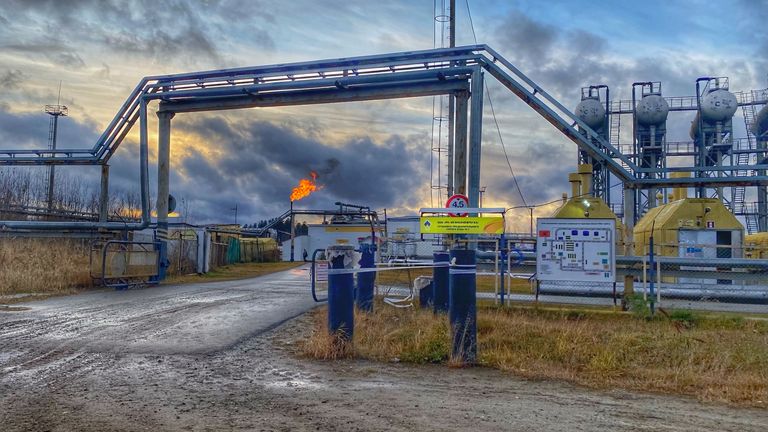Drive through the swamplands of Western Siberia, and you’ll pass one oil installation after the next. This is the largest petroleum basin on Earth and the heartland of Russia’s vast oil and gas reserves.
Pipelines cut through the swampy ground. Fuel tankers thunder past, carrying hydrocarbons for global delivery.
There is not much sense of a climate crisis here.
Surgut is Siberia’s Houston, the oil capital of the region if not the country. Surgutneftegaz (‘neft’ is Russian for oil) is the main employer in town. Salaries, like in Russia’s other oil and gas cities, are among the highest in the country. Working for big oil has its perks.
In the city centre, Surgutneftegaz has built a monument in the shape of a fountain of oil, the faces of the oil workers modelled on actual employees.
There we meet a group of young recruits out on a team-building exercise, pretending to be oil pumps, which they do to peals of laughter.
“Climate change doesn’t worry us a lot,” one says.
“We were born here, we got used to the cold. Any climate conditions for us are fine.”
It is a sentiment you’ll hear a lot, especially among Siberians. That warmer temperatures as a result of climate change might not be all bad. President Putin‘s promise of carbon neutrality by 2060 draws blank stares. These youngsters have not heard about it and don’t know what it means.
I ask one of the supervisors if he thinks Russia will make it by 2060.
“Not in our lifetime,” he replies.
Our local driver remembers flying into Surgut in Soviet times, when the night skies were so lit up by flares from the oil fields that you felt you were landing into a fire. There are fewer now, but we still pass plenty, blazing like beacons in the night.
Flaring is when associated petroleum gases (APG) which accumulate during oil extraction are burnt off rather than stored or re-processed. APG is mostly methane, with a few other pollutants mixed in. Burning it to produce carbon dioxide is more environmentally friendly than venting it, releasing it deliberately, but there is still a substantial “methane slip”.
Flare analytics firm Capterio believes the global average methane slip amounts to around 10%, with total CO2 equivalent emissions from flaring therefore at 1.2bn tonnes. The firm estimates that’s around one-and-a-half times as much as the aviation industry emits, or the equivalent of taking every single car in the EU off the roads.
Russia is by far the worst flaring culprit worldwide. At many of the facilities we pass belonging to state oil giant Rosneft, the flares are substantial.
At one plant on the Mamontovskoye oil field where we stop to film, flares emit around six to seven million cubic feet of CO2 equivalent per day.
“That’s a moderate-sized flare on a global scale, but it is still bigger than almost every flare in the United States,” Capterio’s chief executive Mark Davis says – and it is by no means the largest around Surgut.
Those are just the emissions we can see. Then there is the direct release of methane from leaking pipelines or other oil and gas infrastructure, or from venting.
Drone technology means methane leaks are easy to pick up, enabling companies to clean up their act if they’re prepared to make the investment. Satellite technology means you can even spot the leaks from space, meaning companies that don’t can be identified.
If the EU goes ahead with a carbon border adjustment mechanism that would impose a levy on companies for high-carbon supply chains, Russia’s fossil fuel exports to its largest customer base could face substantial costs. No wonder, in Russia, the EU’s so-called “carbon tax” is not popular.
Rosneft has pledged zero flaring by 2030 as part of a sustainability strategy that includes better monitoring of methane emissions along its pipelines and improved processing of APG. These are admirable goals, and it may well reach them.
But what Igor Sechin says – as Rosneft’s chief executive and one of the most powerful men in the country – and what middle managers in remote oil fields actually do in terms of efficient carbon management might prove tricky to marry up.
It is telling that BP – which holds a 19.75% stake in Rosneft – is aiming to be net-zero across the carbon in its upstream oil and gas production by 2050, with the notable exclusion of Rosneft.
It is telling, too, that Russia, as one of the top five methane emitters, has not signed on to the Global Methane Pledge finalised at COP26 which requires signatories to slash their methane emissions by 30% by 2030.
Subscribe to ClimateCast on Spotify, Apple Podcasts, or Spreaker.
The US president has reprimanded Russia, and China, for not showing up in Glasgow. But President Putin has come a long way in a short time on climate change, his absence probably more to do with not wishing to be scolded on other geopolitical points of difference than because he’s not engaged with the issue.
In a video address to the G20, he claimed Russia was among the world’s decarbonisation leaders. He also listed the reduction of associated gas discharge from the oil industry as one of a number of steps being taken to reduce greenhouse gas emissions.
But the flares we saw are one small measure of the distance Russia still has to travel. And the emissions from flaring, venting and leaking are just a fraction of what we burn from the consumption of fossil fuels.
Unless global habits change, Russia will continue to rely on oil, gas, and coal exports as countries muddle their way through the energy transition.
From Western Siberia, the end of the oil era looks like it’s still a long, long way off.
For full coverage of COP26 watch Climate Live on Sky channel 525.
Follow live coverage on web and app with our dedicated live blog.
Get all the latest stories, special reports and in depth analysis at skynews.com/cop26







